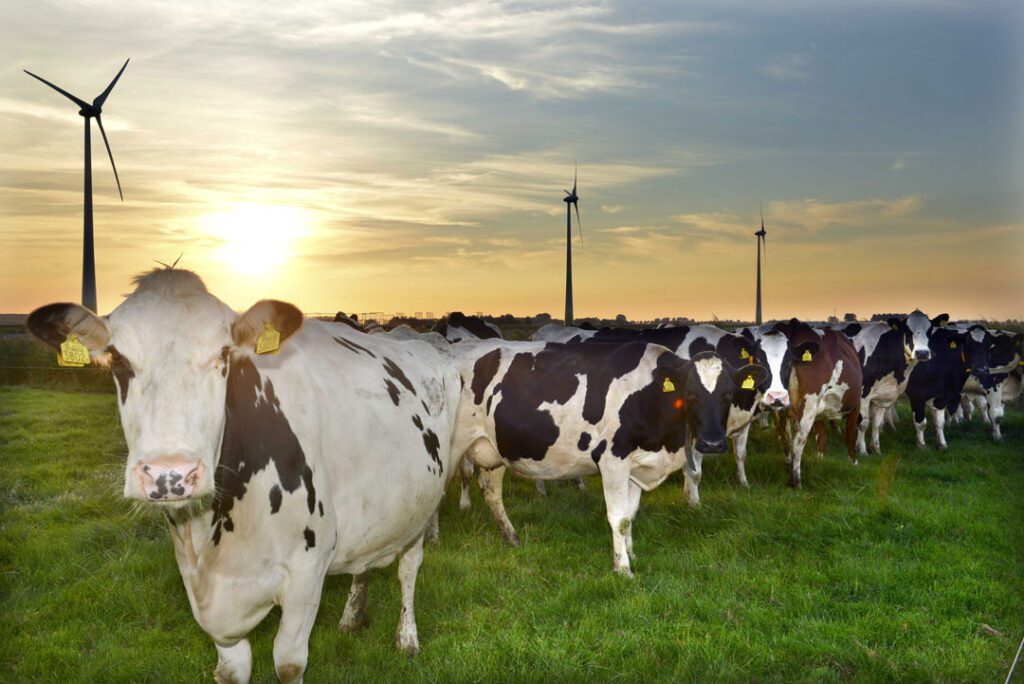Share this page
Dairy chain jointly strives for a future proof and responsible dairy sector
The dutch sustainable dairy chain initiative


Alignment with SDGs
AUTHOR
Bregje van Erve; Tjitske Bolt Duurzame Zuivelketen (Sustainable Dairy Chain) • The Netherlands
Introduction
Through the Sustainable Dairy Chain, an initiative drafted in 2010, dairy organizations (NZO) and dairy farmers (LTO) in the Netherlands work together towards a dairy sector that is future-proof and responsible. In the dairy chain, we want our work to be safe and satisfying; we want to earn a good income, produce high-quality food, respect animals and the environment, and be appreciated by Dutch society.
The Sustainable Dairy Chain has formulated four main objectives to work on: 1) climate-neutral development 2) continuous improvements in livestock health and welfare 3) preservation of grazing 4) protecting biodiversity and the environment. The Sustainable Dairy Chain initiative requires annual updates on the progress towards these objectives, so they can be evaluated, both with partners involved and with societal organizations. The reporting must be based on the best available quantitative information.
The sector report, drawn up by Wageningen Economic Research, describes the objectives as pursued by the Sustainable Dairy Chain, the indicators that were chosen to monitor the progress of these objectives, and the performance related to these objectives in 2017. Through the Sustainable Dairy Chain, Dutch dairy companies and dairy farms joined forces to contribute to goals set on the themes climate-neutral development, continuous improvements in livestock health and welfare, preservation of grazing and protection of biodiversity and the environment.
The Sustainable Dairy Chain is a member of the Dairy Sustainability Framework.
Working towards a future proof and sustainable dairy sector in a structural manner
All the dairy companies in the Netherlands have designed their own sustainability program in order to achieve the goals set in the Sustainable Dairy Chain. In these sustainability programs the farmers share their new knowledge on reducing their impact and they can compare their efforts and results with each other. Furthermore, they can qualify for extra financial means if they make progress to achieve their own sustainability goals. Measures will be taken if the farmer does not take the responsibility to move ahead.
Through the Sustainable Dairy Chain, Dutch dairy companies and dairy farms joined forces to contribute to goals set on the themes climate-neutral development, continuous improvements in livestock health and welfare, preservation of grazing and protection of biodiversity and the environment.
Bregje van Erve Tweet
History of success
Over the years progress has been made in many of the themes. Looking at the latest report, we see progress when comparing 2017 to 2016. Objectives have been achieved for responsible use of antibiotics, energy efficiency, and sustainable soy. The results have only declined for lifespan. Although a downward trend was visible in the greenhouse gas emissions by the dairy chain for the first time, a trend also visible for the ammonia emissions, still the achievement of the objective is very challenging. There is an upward trend for grazing, and the targeted level of 81.2% of farms with grazing is within reach. On the themes Animal welfare and biodiversity progress was made by the development of the monitoring system.
Besides the monitoring of the Sustainable Dairy Chain, the model Annual Nutrient Cycle Assessment (ANCA) was developed and introduced to the dairy farmers. ANCA is constructed to provide indicator values for the utilisation of feeds and fertilisers, including manures, and for losses of harmful products. Reference and normative values are presented as comparisons. With the farm specific values of the performance indicators, dairy farmers can justify their farm management towards authorities and the milk processing industry.
The Sustainable Dairy Chain goals set for 2020 are:
1. Climate-neutral development, related to dairy farming as well as the dairy producer and transport:
- 20% reduction of greenhouse gasses by 2020 relative to 1990 and climate neutral development
- 16% production of sustainable energy by 2020
- 2% improvement energy-efficiency per year in the period 2005-2020
1. Climate-neutral development, related to dairy farming as well as the dairy producer and transport:
- 20% reduction of greenhouse gasses by 2020 relative to 1990 and climate neutral development
- 16% production of sustainable energy by 2020
- 2% improvement energy-efficiency per year in the period 2005-2020
3. Preservation of grazing (related to dairy farming)
Grazing kept at least at its 2012 level: 81.2%
4. Protecting biodiversity and the environment (related to dairy farming)
100% responsible soy (RTRS)
Phosphate and ammonia levels remain within the environmental boundaries
No net biodiversity loss
All the stakeholders in the dairy chain are committed to the Sustainable Dairy Chain
The Sustainable Dairy Chain consists of a steering group, contact group, program teams and a Sustainable Dairy Chain’s advisory board. Due to cooperative effort between dairy farmers, retailers, advisors, politicians, social organizations, science and education, steps forward have been made.
Moving the wheel
In their 2017 monitoring report, Wageningen Economic Research is positive about the initiative: “it gives a concrete picture of performance at a company level, it develops concrete action perspectives for dairy farmers and organizes incentives in a way that the change is actually implemented.” Wageningen Economic Research underlines that it is important to view and develop the Sustainable Dairy Chain integrally and recommended to look ahead and think about the vision and targets after 2020 as well as to execute a materiality analyse. Wageningen Economic Research also recommends an evaluation of the approach and management of the initiative and, based on the results, improve approach and management.
Further information
on the Sustainable Dairy Chain on the website.






